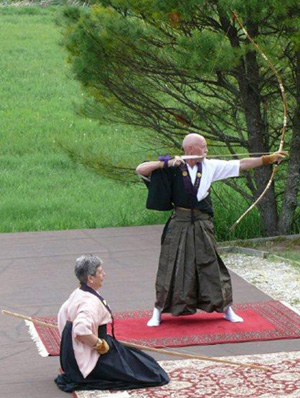Kyudo - A Brief History

Jack & Lj Stewart open the Karme Choling
40th Anniversary Celebrations 2010
Kyudo, The Way of the Bow, is the traditional Japanese art of archery or bowmanship. Though the practice of Kyudo
dates back more than 500 years, the use of the bow is almost as old as the human race. There are two general
classifications of Japanese archery: ceremonial and combat.
As far back as the 7th and 8th centuries, a complicated ceremonial form of archery was practiced by the Japanese
imperial court. This form of bowmanship has its roots in the Shinto religion and is rarely known or practiced outside
Japan.
The combat form of bowmanship derives from the Samurai, or warrior class, who were the only ones allowed to carry and
use weapons. The bowmen of the Samurai were especially respected and effective as they wore armor and shot from
horseback.
Fifteenth century Japan was a time of unrest and many of the warriors were displeased with the rulers. In order to
stimulate a revolt, they began to teach the peasants how to use weapons, including the bow. Heki Danjo Masatsugu was
one such warrior. In the 1440s he founded the Heki Ryu school of bowmanship. Since peasants did not have the armor or
horses of the warriors, Heki Danjo developed a technique that allowed shooting from a standing position.
While much of Kyudo tradition is derived from ancient Shinto practice, Zen became a powerful influence in the 12th and 13th
centuries as warrior archers looked to Zen for their moral code. In the 17th and 18th centuries, while Japan was experiencing a
period of peace, Zen became an even greater influence and the philosophical side of Kyudo became more developed.
In modern times, most practitioners see Kyudo as a spiritual discipline or meditation. The goal is not to hit the target, but to
open one's heart and spirit to the technique. When all is in balance, the arrow will reach the target.
